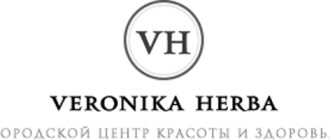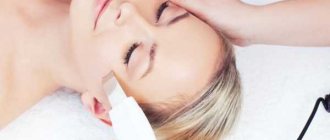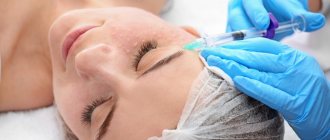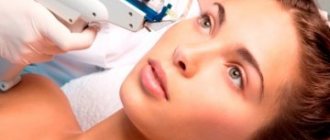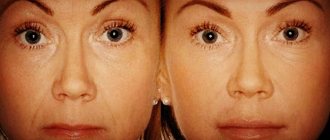What is the difference between mesotherapy and biorevitalization?
They differ in the following parameters:
- the duration of maintaining the achieved result;
- number of recommended procedures;
- the speed of onset of visible effect from the technique;
- use of liquids for injections;
- cost.
Also, each of them has its own characteristics of implementation and method of drug administration.
What is the difference between biorevitalization and mesotherapy? With biorevitalization, papules may form at injection sites, and fibrosis and lymph stagnation may also develop.
What can be achieved through biorevitalization?
Using this technique, it is possible to find solutions to many problems:
- prevent early aging and aging of the skin;
- preserve and make the oval of the face clearer;
- get rid of acne and other inflammations;
- make scars and acne scars less noticeable;
- reduce and lighten dark circles under the lower eyelid;
- get rid of facial wrinkles;
- prevent the appearance of age wrinkles;
- smooth out and lighten stretch marks;
- completely eliminate cellulite;
- improve skin color;
- narrow enlarged pores;
- get rid of rosacea;
- remove the vascular network;
- make age spots less noticeable;
- moisturize severely dehydrated and dry skin;
- speed up the recovery period after plastic surgery, etc.
What is biorevitalization and facial mesotherapy?
Mesotherapy is one of the first popular injection procedures. It helps not only in the fight against age-related changes, but also with cellulite, hair loss, and also as an additional method of treating gynecological and neurological diseases.
Biorevitalization is a more “narrow” procedure in which a solution of hyaluronic acid is injected deep into the skin.
Schemes for their implementation usually consist of the following stages:
- cleansing and treating the skin with antiseptics;
- local anesthesia, and then applying special markings according to which the injections will be carried out;
- the injections themselves are to a depth of 1 to 3 millimeters (small bumps - papules will form in these places);
- applying anti-inflammatory cream to the treated areas.
Both procedures are quite effective in preventing aging and improving the external condition of the skin. They give faster and more realistic visual results than applying expensive masks, creams, scrubs, serums, the active ingredients of which cannot ensure deep penetration into the layers of the epidermis.
The best results from these two procedures will only be achieved if you take proper care of your face, maintain a healthy lifestyle, and eat properly.
Important: What is better, mesotherapy or biorevitalization, is determined by each client for himself. But before choosing, you definitely need a detailed consultation with a cosmetologist, who will tell you the main differences between these procedures and select a set of procedures specifically for your case. At the same time, he takes into account the condition of the skin, the presence of chronic diseases in the body, the price of the service acceptable to you, and also gives forecasts for future results.
What is mesotherapy?
Mesotherapy is considered to be a cosmetic procedure that ensures the introduction of bioactive substances into the deep layers of the epidermis, in the area of problem areas.
Essentially, these are microinjections containing various medicinal and nutritional compounds. They not only help accelerate regeneration processes and relieve inflammation, but also provide complete nutrition to the skin and saturate it with all the necessary micro- and macroelements. Thus, biorevitalization or mesotherapy are processes aimed at maintaining the natural beauty and youth of the skin by nourishing and moisturizing it.
The essence of mesotherapy
What is mesotherapy? This is an injection procedure in which the following is injected under the skin:
- vitamin and mineral mixtures;
- amino acids, enzymes;
- natural plant extracts;
- low concentration hyaluronic acid (up to 1%);
- medicines, antioxidants.
All these substances are called mesococktails. They are medicinal (allopathic) and homeopathic. The former are aimed at eliminating pressing skin problems, the latter are used for preventive purposes, forcing the cells to repair themselves.
These injection mixtures are divided into:
- rejuvenating,
- antiseptic - to fight acne,
- diuretics for cases of edema;
- lipotic, fighting lymph stagnation.
The composition of these cocktails is combined individually for each client, depending on his financial capabilities, skin condition and desired result. Injections are made into the middle layers of the skin up to 6 mm deep. For this purpose, a mesoinjector is most often used. What it is? This is a device that accurately punctures hundreds of times during a cosmetic procedure to the required depth and correctly doses the liquid solution. Here the effect occurs not only from the injected drugs, but also from microtrauma of the skin, i.e. active renewal is taking place.
Note! Mesotherapy can be performed at home, not in the salon. The main difference is that punctures will be performed not with syringes, but with a mesoscooter, whose needles are shorter, which means they cause less injury and bring less pain.
Also, when used at home, meso-cocktails are not injected deep into the skin, but are applied over the epidermis.
It is clear that the effectiveness of home facial mesotherapy is less than in the salon, but with proper use of the mesoroller, you can also cope with many skin imperfections.
Mesotherapy: what you should know about the procedure
The name is eloquent: in this case, injections are injected directly into the dermis (that is, the so-called intermediate layer of skin). The injection drug itself is a complex cocktail of various medical and homeopathic components. They are always selected and mixed in individual proportions for each patient. The basis of such high-quality mixtures is hyaluronic acid, to which various essential vitamins and other components are added.
The injections themselves are administered using very thin needles. As a result, the skin on the face becomes fresher and more elastic. The cosmetologist himself chooses the specific place where to inject the injection for the most effective result. More details about the procedure.
The essence of biorevitalization
For biorevitalization, injections based on hyaluronic acid with a concentration of 1–3% are used. This “miracle” acid is one of the components of human epithelial, connective and nervous tissue. It also has many functions, namely:
- responsible for tissue regeneration;
- promotes the production of collagen and elastin;
- increases skin elasticity;
- perfectly moisturizes the skin.
Biorevitalization involves punctures into the deep layers of the skin, and certain distances between injections must be maintained. The injected solution is very viscous and gel-like.
Biorevitalization is recommended for women after 40 years of age, when the content of hyaluronic acid in the skin decreases. This cosmetic service is aimed at reducing age-related changes.
When is biorevitalization needed?
Those who are pondering the question of which procedure is better: biorevitalization or mesotherapy should understand that they have a very similar method of execution. As in the first option, in the case of biorevitalization, injections are used. The administered drug should restore injured cells, heal wounds, and restore dehydrated cells.
What is biorevitalization? This is one of the cosmetic procedures that can maximally moisturize skin cells from the inside. Thanks to this, fine wrinkles are quickly smoothed out, and the skin itself becomes more elastic and firm. Both mesotherapy and biorevitalization give the face a healthy appearance and beautiful color.
It is worth noting that biorevitalization can be performed for different areas of the skin, including those covered with hair (head, chest or back).
You can trust the procedure only to highly professional specialists. It is very important that the volume and concentration of the administered substance be correctly calculated. If there is too little of it, then you should not count on a good effect. If there is too much, then a variety of skin reactions, swelling, and severe redness may appear.
Video of the biorevitalization procedure:
There are several main conditions for successful biorevitalization:
- The substance itself in the syringe should be viscous, elastic, somewhat similar to a gel. Thanks to this, it is possible to retain the substance in the skin for the required period of time. A product that is too liquid will quickly flow out through the pores of the skin, so it will not have time to provide proper treatment.
- Hyaluronic acid should not be modified by modern processing methods.
- For 1 ml of injected hyaluronic acid preparation there should be no less than 15 mg.
- The protein residues in the acid must be zero. Foreign protein cannot be absorbed by the body. Therefore, it accumulates under the skin. Subsequently, antibodies begin to be produced and allergic reactions develop.
- The molecular weight of the acid should be clearly established - 1 million Daltons. You can find out about laser biorevitalization here.
One procedure lasts about an hour. Before the procedure, the skin is cleansed and treated with special products. At the client's request, local anesthesia is performed.
The drug can be administered in three different ways:
- linear technique (introducing the drug along lines, for example, along wrinkles or massage directions);
- microinjections (injection occurs only at specific points);
- mesh technique (the drug is administered in both horizontal and vertical directions).
Indications and contraindications for procedures
Mesotherapy and biorevitalization have different effects on the skin, and therefore differ in indications.
The first of those mentioned is recommended for women with the following problems:
- dark spots;
- scars and cicatrices;
- acne;
- rosacea;
- dull skin color;
- increased skin oiliness;
- the presence of small wrinkles;
- aging skin due to age-related changes.
Mesotherapy can be done up to 30 years of age.
Biorevitalization will come to the rescue:
- in eliminating certain wrinkles (“crow’s feet”, wrinkles between the nose and lip, between the eyebrows);
- for tightening facial skin in problem areas.
- when restoring water balance and eliminating dryness;
- in the fight against signs of photoaging;
- in restoring the contour of the face and correcting its shape during sudden weight loss;
- reduction of age spots;
- in accelerating tissue regeneration after injury.
We invite you to watch a video review about the difference between mesotherapy and biorevitalization:
The list of contraindications for mesotherapy and biorevitalization is the same. This:
- pregnancy and lactation period;
- allergy to injection components;
- psoriasis;
- foci of infection, cuts, hematomas at the planned injection sites;
- tendency to form keloid scars;
- elevated temperature due to viral diseases;
- problems with blood clotting or taking medications that reduce blood clotting.
Please note: These two cosmetic procedures cannot be performed together with other hardware treatments on the skin. Biorevitalization is not yet performed on areas of the face that were previously treated with permanent fillers.
Complications are rare if certain conditions are followed:
- correct administration of injections;
- professionalism of a cosmetologist;
- complete sterility;
- use of high quality drugs and equipment.
Number of procedures, speed and duration of results The main differences between mesotherapy and biorevitalization are the duration of preservation of the result, the speed of its onset, and the number of procedures for successful skin rejuvenation.
After biorevitalization, improvements are immediately observed:
- the skin becomes elastic, not flabby;
- the relief is leveled;
- fine wrinkles disappear, and deep ones become less noticeable.
Usually the course consists of 5 procedures with a break of 14 days, although it all depends on the initial condition of the skin. The effectiveness of this cosmetic service is visible for 9 months, after which correction and introduction of new injections of hyaluronic acid are recommended.
Mesotherapy is characterized by a less rapid result; the cumulative effect “works”. A course of 10 sessions with short breaks is required. In this case, skin improvements will be visible gradually from session to session. The result lasts for a year.
Efficiency and number of procedures
Despite the fact that the effect of biorevitalization usually becomes noticeable after the first visit to the salon, when performing both procedures it is important to complete the whole course. This is the only way you can eliminate visible problems on your face and achieve the desired result.
A biorevitalization course usually consists of 5-6 sessions, with a break between them of about two weeks. After the first visit, you will notice a significant smoothing of the skin and an increase in its elasticity. However, when carrying out biorevitalization for preventive purposes, you can get by with 1-2 visits to the salon.
Mesotherapy has a cumulative effect, so the result becomes noticeable later - usually after 2-3 sessions. But the course of introducing meso-cocktails is usually 8-12 sessions, which depends on the treated area and the initial condition of the skin. The break between sessions is 1-1.5 weeks.
Even when performing any of the technologies at home, it is important to complete a course of sessions in order to achieve maximum saturation and transformation of the facial skin.
Price
When choosing between mesotherapy or biorevitalization, of course, take into account the cost. One mesotherapy procedure costs 2 times more than one biorevitalization session. But the number of procedures in a regular course of mesotherapy is approximately two times less than in biorevitalization. Therefore, economically, cost calculations are not very different from each other. The price of mesotherapy depends on the desired composition of meso-cocktails, which is selected by a cosmetologist individually for each client.
Please note: If you decide to receive these services not from a certified specialist in a medical clinic, but from a hairdresser or at home (or from a nurse, which is prohibited by law), you may experience more severe complications, such as skin necrosis. Please know that the law stipulates that a mesotherapist must have a diploma of higher medical education, a certificate of a specialist dermatovenerologist (requires confirmation once every five years), a certificate of advanced training in the field of dermatocosmetology, a certificate of appropriate qualifications in mesotherapy. Having such documents plus a medical license from a cosmetology clinic will give you confidence in the safety of the planned procedure.
Know that if you decide on injection methods of rejuvenation, it is better not to skimp on your health, but to be responsible when choosing a cosmetologist.
The effectiveness of mesotherapy
As a result of mesotherapy, you can observe skin hydration and restoration of epidermal structures. Using this procedure, it is possible to get rid of spider veins, acne, scar irregularities, stretch marks and even cellulite. What is more effective - mesotherapy or biorevitalization? There is not and cannot be a single answer to this question. Mesotherapy can completely remove fine wrinkles, making them almost invisible, and also significantly reduce the depth of large wrinkles. In both cases, injections act locally, without affecting the condition of the body as a whole and without having any effect on other areas of the skin.
What is better – mesotherapy or biorevitalization
So, it may seem that the described procedures for skin rejuvenation are the same, because both are carried out using injections of drugs that act at the cellular level. Indeed, the preparation for the manipulations, the injection process itself and the pain after the session are similar, according to clients. But there are differences between mesotherapy and biorevitalization, which we have already discussed above, and now let’s add the following important facts to the list:
- with mesotherapy, the injection is administered to a depth of 2 mm, and with biorevitalization - at 0.5-1 mm;
- during mesotherapy, up to 500 injections are given in one session, while specific points on the treated area are not selected, and biorevitalization implies a certain number of injections at specific points;
- with mesotherapy, thanks to the use of many injection components, it is possible to find solutions to a greater number of skin problems;
- Mesotherapy is permitted from 18 years of age, and biorevitalization from 30 years of age (when the body already begins a gradual process of reducing the production of its own hyaluronic acid);
The introduction of hyaluronic acid preparations provides a greater effect for the prevention of photoaging, as well as for the rapid restoration of the skin after prolonged sun exposure.
Biorevitalization is considered a more universal remedy, since it has the same effect for everyone, because it is carried out with constant high-quality preparations.
It will also give the best results for deeply moisturizing the skin, correcting the oval of the face, combating wrinkles on the bridge of the nose and in the area of nasolabial folds, since the injected drugs have a dense structure, and therefore are good for filling such defects.
If a woman wants to urgently put herself in order and get instant results, then it is better to opt for biorevitalization. But if you want not only to improve your appearance, but also to instill health in your skin, nourish and moisturize it, activate metabolic processes and natural tissue restoration, then mesotherapy is more suitable.
Important: after mesotherapy, you should not touch the injection sites and only after 6 hours you can wash your face with thermal, distilled or boiled water. Biorevitalization does not have such restrictions.
In general, the use of these cosmetic services is painless for most people. After the session, of course, swelling, itching, even subcutaneous hemorrhages, redness, and thickening of the skin may occur. During the first two days, the client is not allowed to take aspirin and other medications that promote blood clotting; he is also not allowed to rub or comb the skin or apply decorative cosmetics.
Before going outside, be sure to use creams with a high sun protection factor (30-50 SPF). Also, during the recovery period, experts strongly do not recommend going to the pool, sauna, bathhouse, solarium, engaging in active sports or drinking alcoholic beverages.
After biorevitalization or mesotherapy, you must strictly follow the advice of cosmetologists on skin care. The final result will depend on this.
Reviews about these methods are very diverse, sometimes contradictory. There are clients who can no longer do without these cosmetic procedures, thanks to the excellent visible effect. There are women who tried it, but did not really feel the result and regretted the money spent.
There are people who are very disappointed in these procedures, and even received complications that they had to deal with for a long time. Therefore, everything in this matter of returning beauty and youth is very individual.
Recommendations for choosing – which is more effective
Mesotherapy or another procedure - biorevitalization - is ordered, taking into account the cosmetic problems that the woman plans to solve.
Thus, mesotherapy is recommended in the following cases:
- hair loss;
- presence of acne;
- presence of scars;
- the presence of cellulite;
- with noticeable age-related skin changes;
- poor complexion;
- presence of stretch marks.
Biorevitalization is appropriate for:
- small wrinkles;
- dry skin;
- noticeably enlarged skin pores;
- increased sweating;
- skin injuries (including post-operative);
- unhealthy skin color.
Despite the differences in the mechanism of influence of both methods, they have the same contraindications. Among them are the following:
- pregnancy;
- a viral or infectious disease in an acute form, which is accompanied by fever, fever;
- diseases associated with blood clotting;
- cholelithiasis;
- AIDS;
- skin cancer;
- local infectious and inflammatory processes;
- the presence of neoplasms (large birthmarks, papillomas);
- hypersensitivity to the components of the drug. You can learn about injection mesotherapy here.
In the video - which is better: mesotherapy or biorevitalization
If you do not follow all the rules of the procedure, the patient may not cure problem areas of the skin, but on the contrary, cause irreparable harm. Dermatologists name a number of possible side effects after mesotherapy and biorevitalization. Among them:
- local inflammatory processes;
- severe allergic reactions;
- hematomas;
- bruises;
- swelling;
- redness;
- subcutaneous acne;
- pain;
- infection by fungi and infections. You can find out how often you can do facial biorevitalization by following the link.
Undesirable consequences can be avoided. To do this, you should follow just a few simple rules:
- Thoroughly disinfect the skin and syringe before and after the procedure.
- Carefully calculate the dose of the required drug.
- Drugs must be well tested.
- Insert the needle to the optimal depth.
A preliminary test for an allergic reaction is required (involves applying a small amount of the drug to a sensitive area of skin, usually the wrist).
What are the same and how are they different?
Not all women understand the difference between these two procedures, because they have a lot in common. So, both manipulations involve injections, both are aimed at skin rejuvenation. Both treatments leave your skin feeling more hydrated, firmer, firmer and more youthful in appearance.
They cannot differ in the duration of their effect. Both procedures must be performed systematically, otherwise the skin will return to its previous appearance. The desired result cannot be achieved immediately. Whatever type of cosmetic procedure a woman chooses, it must be repeated at least twice or three times. You can learn about papules after biorevitalization in this article.
The main difference between mesotherapy and biorevitalization is the drug that is injected into the skin. Thus, the first procedure involves the use of hyaluronic acid of living origin.
It is different from those substances that are produced by the human body, so it cannot provide a long-term effect. Cosmetologists call mesotherapy a useful procedure, because it also contains a number of microelements beneficial for the skin.
On video, the difference between mesotherapy and biorevitalization:
Biorevitalization also uses hyaluronic acid, but in its non-living version. Its main advantage is that the substance itself does not make the skin elastic, but breaks down into active particles in the skin, forcing the body to actively produce its own hyaluronic acid and thus make the face look younger.
The difference between mesotherapy and biorevitalization lies in the recommended age of the client. So, the first one is more suitable for women over 40 years old. It is at this age that it is important to restore the good condition of old tired skin cells. The second option of cosmetic procedures is more gentle, therefore it is recommended for younger women (from 25 years old). Its main task is to nourish and vitaminize still young cells that require protection from aging.
Which method is better?
It is difficult to answer the question of what is more effective: mesotherapy or biorevitalization, because both methods can be useful and will give a woman youth. To make the right choice, you need to take into account a number of nuances, in particular:
- woman’s age – if more than 40, then it is better to choose mesotherapy, but if the woman has not yet reached Balzac’s age, then you need to choose biorevitalization;
- skin condition – minor skin problems can be solved thanks to non-living hyaluronic acid, deeper wrinkles and acne marks can overcome the effect of biorevitalization;
- expenses - a woman must take into account both the price of the procedure and the fact that there should be several such procedures. If the budget is limited, it is better to give preference to biorevitalization (it will cost 900-1500 rubles for 1 session), but if the money spent does not become a problem for the woman, you can use mesotherapy (the cost of one injection ranges from 3 to 6 thousand rubles).
Biorevitalization differs from mesotherapy in the time spent on the procedures. If there is a lot of it, then you can safely sign up for sessions first. If you need a quick effect with minimal time investment, it is better to give preference to the second one.
It is not recommended for a woman to independently choose which method should be used: biorevitalization or meso. Permission must be obtained from an experienced dermatologist or cosmetologist. First, the skin should be carefully examined under a magnifying glass, its main pathologies and manifestations of age-related changes should be identified, and only then treatment should be applied. Sometimes experts recommend that a woman undergo a general blood test and a blood test for hormones before the procedure.
Of course, every woman wants to remain young and attractive for as long as possible, so modern cosmetic methods are very useful for achieving these goals. At the same time, in order to avoid undesirable effects, a woman must first find out for herself how mesotherapy differs from biorevitalization, how these procedures are carried out and what side effects they may have. We also recommend that you familiarize yourself with mesotherapy with vitamin C in this material.
Photo after biorevitalization
Numerous photographs of women’s faces after biorevitalization show wonderful results! The skin becomes noticeably younger, deep wrinkles are not so pronounced, pigment spots practically disappear, facial wrinkles on the forehead and around the eyes are smoothed out, nasolabial folds disappear. The skin receives a powerful charge of hydration and simply glows!
These photos once again prove the effectiveness of the procedure, which helps preserve youth and beauty without painful, sometimes dangerous, surgical interventions.
Injection methods of lifting and rejuvenation
The most effective technologies in the field of cosmetology are those that involve the injection of useful compounds into the structure of the epidermis.
Mesotherapy and biorevitalization are two similar minimally invasive procedures that help restore youthful skin and eliminate visible defects.
Injection methods have two directions of action on the skin:
- Introduction of special compounds that saturate the skin with beneficial substances, increasing local immunity.
- Awakening of natural metabolic processes in the epidermis and activation of the regulation of epithelial cells. They usually fade with age, and the procedure allows them to be restored.
Due to this impact, the techniques provide a lifting effect after completing a course of sessions.
How are these two methods different?
So what is the difference between mesotherapy and biorevitalization, if the essence of the methods is similar? Let's try to figure it out. The main difference between mesotherapy and biorevitalization is the composition of the cocktail. Biorevitalization not only provides cells with an additional amount of vital elements, but also promotes the natural production of collagen and elastin, which are responsible for maintaining youth and inner radiance.
After the biorevitalization procedure, the skin glows with youth and beauty. To make cocktails in mesotherapy, hyaluronic acid is also most often used, but many other elements are also added to it.
Quite often these two methods are confused. In addition, patients at cosmetic centers have a question: biorevitalization or mesotherapy - which is better?
Both techniques are very similar, and both are injectable. The main goal of both mesotherapy and biorevitalization is to rejuvenate the skin and restore its structure. Both of these procedures can fully moisturize the skin, help increase the elasticity of the epidermis, smooth out and make wrinkles less noticeable. So it is impossible to say unequivocally: biorevitalization or mesotherapy - which is better and which is worse. The difference lies in the composition of the administered drugs and the advisability of using this particular cocktail in this particular case. But the cases are different. After all, it is impossible to compare therapy aimed at getting rid of cellulite or spider veins with methods that allow you to smooth out fine wrinkles.
Features of the procedure and benefits
Most modern cosmetics contain hyaluronic acid. But when applied simply to the surface of the skin, they are not properly absorbed into the deeper layers. Laser biorevitalization with hyaluronic acid allows the substance to penetrate into the deepest layers of the epidermis. As a result, hyaluronic acid molecules act on the skin at the cellular level and stimulate the natural production of elastin and collagen. In addition, intensive nutrition and hydration of the dermis occurs.
The undeniable advantages of laser biorevitalization of facial skin are:
- regulation of skin hydrobalance;
- the ability to make the skin firmer and more elastic;
- skin cell regeneration;
- clear anti-inflammatory effect;
- improvement of blood microcirculation in tissues;
- increasing the immunity of the dermis;
- saturation of skin cells with oxygen;
- protecting the skin from free radicals.
Another key advantage of laser exposure is the simplicity and safety of the procedure. If you have the skills to operate the device, such biorevitalization does not require special diplomas or certificates.
Laser biorevitalization is a double help for the body, since the procedure has both rejuvenating and healing effects. A noticeable effect appears after the first procedure.
But, despite all the obvious advantages, laser biorevitalization has certain contraindications for use:
- oncological diseases, the presence of malignant tumors;
- blood diseases, clotting problems;
- pregnancy and breastfeeding;
- diseases of the cardiovascular system, hypertension, atherosclerosis;
- psoriasis, eczema, atopic dermatitis in the acute stage;
- hypersensitivity or individual intolerance to hyaluronic acid;
- infectious diseases (flu, ARVI);
- moles, tattoo in the area of intended impact;
- pulmonary tuberculosis;
- age under 18 years;
- epilepsy.
How is biorevitalization carried out?
The procedure is prescribed only after an individual visit to the cosmetologist by the patient. During the first visit, the specialist assesses:
- the condition of the client’s skin at the time of treatment;
- patient's age;
- individual skin characteristics (acne, pigment spots, scar changes).
The cosmetologist also discusses the desired effect of the procedure with the patient. Based on examination data and medical history, the specialist creates an individual rejuvenation program for the client by introducing hyaluronic acid under the skin. As a rule, this is:
- An intensive course of 4-6 procedures at intervals of a couple of weeks.
- Maintenance therapy once every 3-6 months, depending on the individual characteristics of the skin.
Duration of the effect of mesotherapy and biorevitalization
It is worth noting that the effect of biorevitalization is quite long-lasting. After the procedure, the skin is maximally moisturized and nourished with nutrients. The durability of the biorevitalization effect can be explained not only by the action of the substance itself, but also by the presence of its own hyaluronic acid in the skin.
However, when looking for an answer to the question: biorevitalization or mesotherapy - which is better, you can come across quite contradictory reviews. After all, in mesotherapy the same hyaluronic acid is used, but not of chemical, but of animal origin. It is somewhat different from the same substance produced by the human body. That is why this type of hyaluronic acid simply cannot remain in the layers of the epidermis for a long time. It will be eliminated by the body much faster. Thus, the effect of mesotherapy can last only seven days. However, the advantage of mesoprocedures is that the effect can be observed almost immediately after they are performed. The cocktails contain useful microelements, minerals, vitamins, etc.
If the disadvantage of mesotherapy is the need for frequent procedures, then biorevitalization can please the patient with a long-lasting and lasting result. However, it will not be possible to observe it immediately. The visible effect occurs after a certain period of time after the procedure. Therefore, you should take into account the client’s age, individual characteristics and preferences, as well as a lot of other nuances, before answering the question: “Biorevitalization or mesotherapy - which is better?”
Biorevitalization after mesotherapy
Is it possible to carry out biorevitalization after mesotherapy and when?
Patients often turn to a cosmetologist for biorevitalization after mesotherapy. Is it possible to do this even after how long after the first procedure? Experts assure that biorevitalization can be carried out after mesotherapy, the effect of which, for objective reasons, does not suit the patient. Doctors advise you to wait at least a few weeks between procedures, after which you can safely contact a cosmetology center for the next stage of rejuvenation.
Benefits of biorevitalization
Biorevitalization of facial skin, reviews of which are mostly positive, has a number of visible advantages. Among them:
- no side effects from the procedure;
- accelerated and shortened recovery period;
- relative painlessness;
- an incredible effect visible to the naked eye.
Since hyaluronic acid gel is almost identical in composition to natural ingredients - acid produced by human skin, the likelihood of side effects is almost completely eliminated.
In the vast majority of cases, mesotherapy or biorevitalization reviews are very positive. They are well tolerated by the body and do not entail any unpleasant consequences.
Side effects and contraindications for biorevitalization
Side effects associated with violation of the biorevitalization technique will not differ from similar consequences from the introduction of cocktails. This:
- allergic reactions to hyaluronic acid;
- high concentrations of hyaluronic acid more often cause the development of scars, skin atrophy (decrease in volume), pigmented and depigmented spots;
- Small nodules may form at the injection site, creating unevenness on the facial skin.
Contraindications for both methods are no different.
